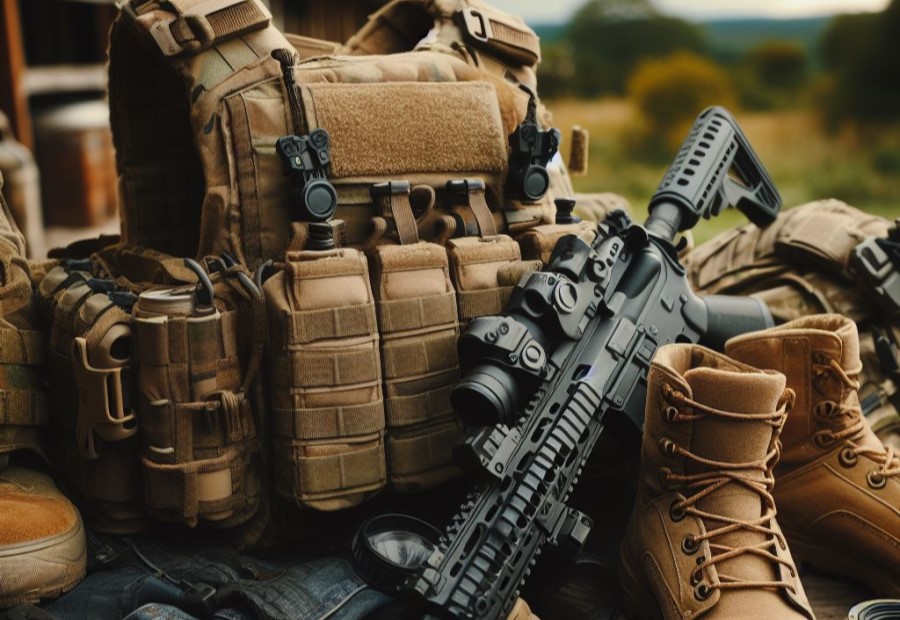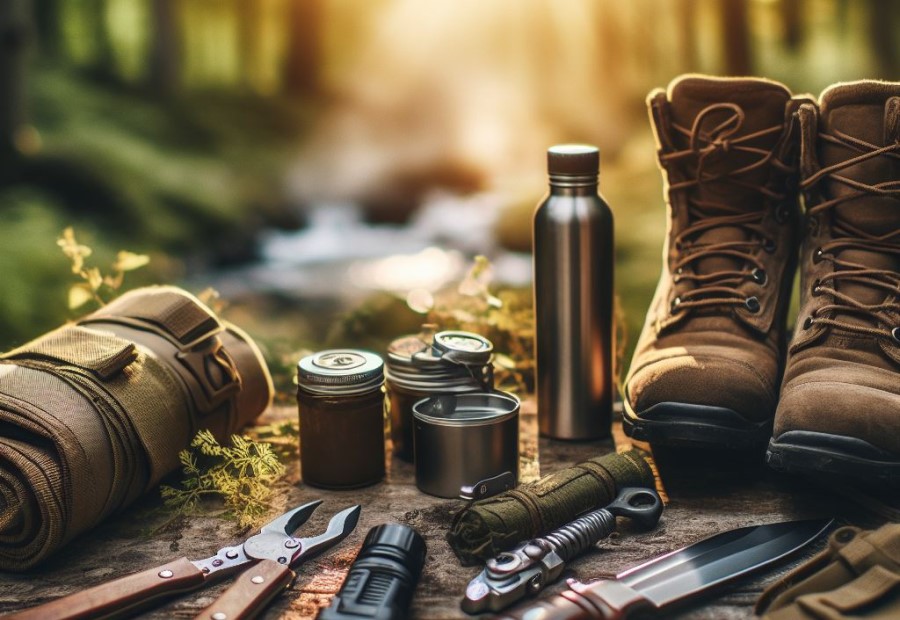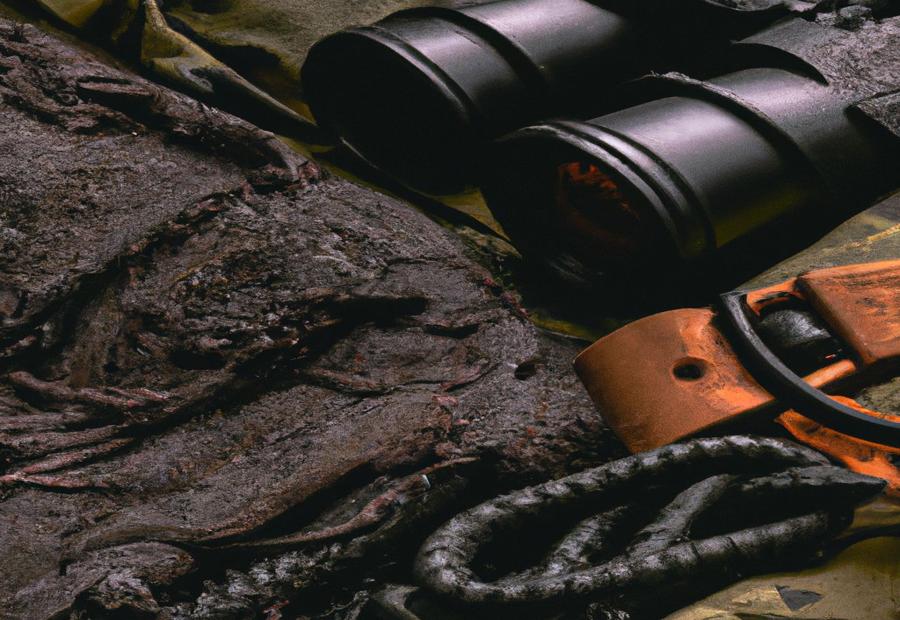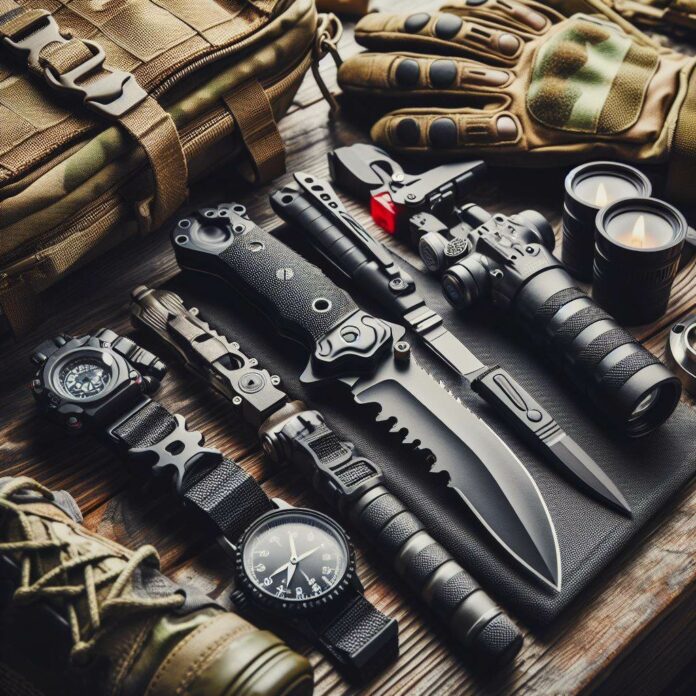Tactical gear and survival gear are two terms often used interchangeably, but they are distinct in their features, purposes, and intended uses. Understanding the difference between tactical and survival gear is essential for selecting the right equipment for your specific needs and situations.
Tactical gear refers to equipment and clothing designed for military, law enforcement, and emergency response personnel. It is optimized for high-performance and quick response in tactical situations. Tactical gear is built to withstand rugged environments, provide protection, and offer functionality in combat or intense operational scenarios.
On the other hand, survival gear is designed for individuals who need to sustain themselves in challenging outdoor environments or during emergencies. It includes items necessary for survival, such as first aid kits, fire starters, food/water supplies, shelter, navigation tools, and other essentials.
Survival gear focuses on self-sufficiency and preparedness in unpredictable situations, like natural disasters or when stranded in remote locations.
The key differences between tactical gear and survival gear lie in their function and purpose, design and construction, intended use, and availability/accessibility. Tactical gear is primarily meant for professional use and is often built with specialized features for tactical missions.
Survival gear, on the other hand, is designed for civilian use and emphasizes practicality and versatility in outdoor survival situations.
When choosing between tactical gear and survival gear, it is essential to consider your specific needs and circumstances. If you require equipment for professional applications or self-defense purposes, tactical gear is more suitable. If you enjoy outdoor activities or want to be prepared for emergencies, survival gear will better serve your requirements.
By understanding the distinctions between tactical gear and survival gear, you can make informed decisions and select the appropriate gear for your specific needs, ensuring your safety, preparedness, and peace of mind in any situation.
Understanding Tactical Gear

Understanding Tactical Gear is crucial when it comes to selecting the right equipment for specific needs and activities. Tactical gear is a type of equipment that is designed for tasks or situations that require preparedness and efficiency.
It is commonly used by military personnel, law enforcement officers, and outdoor enthusiasts. The gear is made from durable materials such as nylon or polyester, which can withstand harsh conditions.
Key components of tactical gear include vests, backpacks, holsters, and pouches. These components provide storage and easy access to essential items. The gear is designed with functionality in mind, allowing wearers to carry weapons, ammunition, communication devices, and other necessary tools.
Additionally, tactical gear often features MOLLE (Modular Lightweight Load-carrying Equipment) webbing, which enables customization and allows for the attachment of additional accessories.
Comfort and mobility are also prioritized in tactical gear. The gear includes adjustable straps, padding, and ventilation systems to ensure comfort during use. Furthermore, tactical gear considers camouflage and concealment with patterns and colors designed to blend into specific environments. This helps users stay hidden and undetected when necessary.
Whether for professional use or personal preparedness, understanding how tactical gear enhances performance and provides necessary tools is essential. By having a comprehensive understanding of tactical gear, individuals can make informed decisions when choosing the right equipment.
What is Tactical Gear?
Tactical gear, also known as equipment and accessories, is specifically designed to meet the needs of military and law enforcement personnel in combat or high-risk situations. Its primary purpose is to enhance their effectiveness and ensure their safety. The characteristic features of tactical gear include durability, functionality, and versatility.
The main aim of tactical gear is to provide the wearer with the necessary tools and equipment to carry out their missions effectively. This includes body armor, helmets, tactical vests, backpacks, footwear, gloves, and various weapons and accessories.
Tactical gear is engineered to withstand harsh environments and extreme conditions. It is manufactured using high-quality materials that can endure heavy use and provide protection against impacts, projectiles, and environmental hazards.
The functionality of tactical gear is paramount for the wearer’s mobility, agility, and preparedness. It allows for quick and easy access to essential equipment and supplies, ensuring that everything is readily available when needed.
Tactical gear is not exclusive to military and law enforcement use. It is also widely utilized by outdoor enthusiasts, survivalists, and everyday individuals who appreciate its practicality and reliability in various situations.
What are the Features of Tactical Gear?
The features of tactical gear include:
- Durability: Tactical gear is designed to withstand tough conditions and frequent use.
- Functionality: Tactical gear is equipped with various pockets, compartments, and attachments to hold and organize essential tools and equipment.
- Versatility: Tactical gear is adaptable for different situations and can be customized with modular components.
- Camouflage: Tactical gear often features camouflage patterns to blend in with the surroundings.
- Quick accessibility: Tactical gear is designed for easy and quick access to essential items to ensure efficiency during critical moments.
Fact: Tactical gear is not only used by military and law enforcement personnel but also by outdoor enthusiasts, adventurers, and survivalists.
Understanding Survival Gear

Understanding survival gear is crucial for anyone who spends time in the great outdoors or wants to be prepared for emergencies. Here are some key points to consider:
- Know the essentials: In order to be well-prepared, it is important to have a comprehensive survival gear that includes items such as a first aid kit, water purification system, fire starter, shelter, multi-tool, and navigation tools.
- Consider your environment: Depending on your geographical location or the places you plan to visit, the specific gear you require may vary. For instance, if you frequently venture into cold climates, it is vital to have appropriate sleeping gear and warm clothing.
- Quality matters: When it comes to survival gear, investing in durable and reliable equipment is of utmost importance. Never make compromises on the quality of your gear, as it may determine whether you survive or not in critical situations.
- Learn how to use your gear: Just owning survival gear is not sufficient; you must also possess the knowledge and ability to utilize it effectively. Take the necessary time to understand how to operate and maintain each item in your kit.
By having a thorough understanding of survival gear and equipping yourself with the appropriate equipment, you greatly enhance your chances of staying safe and protected during unexpected situations. Always remember, being prepared is the ultimate key to survival.
What is Survival Gear?
Survival gear is a collection of essential tools and equipment specifically designed to assist individuals in handling emergency situations or outdoor adventures. This gear is intended to provide the necessary resources for sustaining life, ensuring safety, and promoting well-being in challenging environments or unexpected events.
Typically, survival gear consists of various items, including a first aid kit, fire starters, a multi-tool, a compass, a flashlight, emergency food and water, a shelter, and protective clothing.
These items are carefully selected to meet specific needs such as navigation, communication, warmth, hydration, and personal protection. So, what exactly is survival gear? It is the ultimate means of preparation and survival in even the most daunting circumstances.
What are the Features of Survival Gear?
The features of survival gear can vary depending on the specific product and its intended use. Here are some common features to consider:
1. Durability: Survival gear is designed to withstand harsh conditions and heavy use. Look for gear made from high-quality materials such as strong nylon or reinforced steel.
2. Versatility: Survival gear often serves multiple purposes. For example, a multi-tool can include functions like a knife, saw, and can opener, making it useful in various situations.
3. Portability: Survival gear should be lightweight and compact, allowing you to easily carry it in a backpack or emergency kit. Look for gear that can be easily folded or collapsed for efficient storage.
4. Waterproof or water-resistant: In survival situations, staying dry is crucial. Look for gear that is water-resistant or waterproof, such as waterproof jackets, bags, or containers.
5. Safety features: Survival gear may include features such as reflective materials for visibility, built-in whistles for signaling, or fire starters for warmth and cooking.
6. Functionality: Survival gear should have practical functions that aid in survival, such as first aid kits, compasses, signaling devices, or a means to purify water.
Key Differences Between Tactical Gear and Survival Gear
Function and Purpose
The function and purpose of tactical gear and survival gear are distinct and serve specific roles in different situations.
- Tactical Gear: Tactical gear is designed for use by military, law enforcement, and other professionals in high-intensity situations. Its primary function is to enhance performance, provide protection, and aid in carrying out tactical operations. The purpose of tactical gear is to improve efficiency, effectiveness, and safety in combat, emergency response, and other challenging scenarios.
- Survival Gear: Survival gear, on the other hand, is intended for individuals who may find themselves in outdoor or wilderness environments with limited resources and support. Its main function is to help individuals stay prepared and survive in emergency situations. The purpose of survival gear is to provide tools, equipment, and supplies that enable individuals to meet their basic needs, such as shelter, food, water, and first aid, when faced with unexpected circumstances.
Design and Construction
In understanding the differences between tactical gear and survival gear, it is important to consider the design and construction of each.
- Tactical Gear:
- Tactical gear is designed with durability in mind, using high-quality materials such as nylon or polyester.
- It features reinforced stitching and heavy-duty zippers to withstand demanding situations.
- The design and construction of tactical gear includes multiple compartments and pockets for easy organization of tools and equipment.
- It is often designed with MOLLE (Modular Lightweight Load-carrying Equipment) system, allowing for customization and attachment of additional gear.
- Tactical gear is typically available in various camouflage patterns to blend in with different environments.
- Survival Gear:
- Survival gear is also constructed using durable materials, but it focuses more on lightweight and compact designs.
- It is designed to be easily carried and stored in emergency situations.
- Survival gear often includes multipurpose tools, such as a knife with integrated tools or a compact survival kit.
- The design and construction of survival gear emphasizes portability, with features like foldable designs or compact storage solutions.
- Survival gear is available in different sizes and designs to accommodate different survival scenarios.
Pro-tip: When choosing between tactical gear and survival gear, consider the specific scenarios and needs you anticipate. If you require durability and customization for tactical situations, tactical gear may be the better choice. For lightweight and portable options for emergency situations, survival gear is the way to go.
Intended Use
When considering the intended use of tactical and survival gear, there are significant differences to take into account. A comparison table can help illustrate these distinctions:
When choosing between tactical and survival gear, it is crucial to consider the intended use. Tactical gear, typically used by military, law enforcement, and security personnel in high-risk situations, emphasizes functionality and efficiency to support tactical operations and combat situations.
On the other hand, survival gear is designed for individuals who may find themselves in emergency or wilderness survival scenarios, focusing on self-sufficiency and providing essential tools for survival in remote environments.
Tactical gear includes features like MOLLE attachments, camouflage patterns, and quick-access compartments, while survival gear incorporates tools for shelter building, fire starting, water purification, and navigation.
Tactical gear is intended for use during specific missions or operations, while survival gear is designed for preparedness in unpredictable situations, such as natural disasters or getting lost in the wilderness.
Tactical gear is readily available to military and law enforcement agencies, while survival gear is accessible to the general public and outdoor enthusiasts.
Ultimately, when choosing between tactical and survival gear, it is essential to assess your own needs and circumstances to determine which type of gear is most suitable for your intended use.
Availability and Accessibility
When deciding between tactical gear and survival gear, it is crucial to consider the aspects of availability and accessibility.
- Availability: Tactical gear is widely accessible, as it is commonly utilized by military, law enforcement, and security personnel. It can be easily purchased from specialized stores, online retailers, and even some general sporting goods stores. Conversely, survival gear may be less readily available and might require searching for specialized outdoor or camping stores.
- Accessibility: Tactical gear is specifically designed to be easily accessible in high-pressure situations. It typically features quick-release buckles and adjustable straps, allowing for quick and effortless access to essential tools and equipment. On the other hand, survival gear prioritizes portability and compactness, aiming to be lightweight and easily carried in outdoor settings.
Choosing the Right Gear for Your Needs

Photo Credits: Paintballbuzz.Com by Walter Williams
When it comes to choosing the right gear for your needs, you need to consider several factors. Assess the specific activities or scenarios you will encounter, whether it’s camping, hiking, or emergency situations, and make sure the gear is suitable for your intended purpose.
Look for gear made from high-quality materials and designed to withstand wear and tear, ensuring durability and reliability in challenging situations. Consider the features and functions that are important to you, such as multiple pockets for organization or waterproofing.
Choose gear that meets your specific requirements. Comfort is key, especially if you’ll be wearing the gear for extended periods. Look for adjustable straps, padding, and ergonomic designs that ensure a better fit and reduce discomfort.
Determine your budget range and find gear within that price range, striking a balance between affordability and quality. By considering these factors, you can choose the right gear that aligns with your needs and enhances your overall experience in various situations.
Frequently Asked Questions
What’s the difference between tactical and survival gear?
Tactical and survival gear differ in several aspects, including design, materials, and intended use.
What are the key features of tactical gear?
Tactical gear, such as tactical knives, is designed for military or combat use. It often has a plain design, subdued colors, and features like finger grooves, aggressive texture, and rubberized grips for a secure and comfortable grip. Tactical gear is optimized for battlefield tasks and can also function as a self-defense weapon.
What are the main characteristics of survival gear?
Survival gear, including survival knives, prioritizes utility and survival tasks. It comes in various colors and uses both natural and synthetic grips. Survival gear usually has handles designed to provide a good grip for a variety of tasks, without aggressive texturing or large finger grooves.
Survival knives have blades optimized for chopping, batoning wood, and general outdoor use.
What are the differences in handle design between tactical and survival gear?
Tactical gear often has handles with aggressive textures, finger grooves, and rubberized grips, offering a secure grip even in wet or bloody conditions. Survival gear, on the other hand, tends to have handles with a rougher texture and a more comfortable grip for general-purpose tools and utilitarian purposes.
What materials are used in the blades of tactical and survival gear?
Tactical gear typically uses stainless steel blades, known for their sharpness and corrosion resistance. Survival gear often utilizes carbon steel blades, which are easier to sharpen but require more maintenance. The choice between the two depends on personal preference and specific needs.
Which situations are tactical and survival gear suitable for?
Tactical gear is appropriate for military environments, combat situations, or self-defense scenarios. Survival gear, such as survival knives, is recommended for general outdoor use, bush crafting, and surviving in wooded areas.

